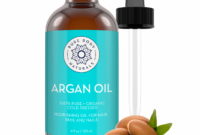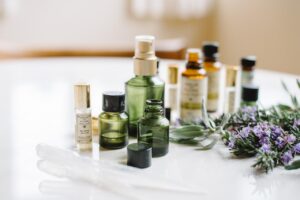Essential oils and uses – Essential oils and their uses have captivated humanity for centuries, weaving a rich tapestry of tradition, science, and everyday applications. These fragrant essences, extracted from the very heart of plants, hold a treasure trove of therapeutic properties and versatile applications that continue to inspire and empower us today.
From ancient rituals to modern aromatherapy, essential oils have played an integral role in promoting well-being, enhancing beauty, and purifying our surroundings. Let us delve into the captivating world of essential oils, exploring their chemical composition, therapeutic benefits, extraction methods, safety considerations, and diverse applications across industries.
Introduction
Essential oils are natural, volatile compounds extracted from plants. They are obtained through various methods, including steam distillation, cold pressing, and solvent extraction. Essential oils have been used for centuries in traditional medicine, aromatherapy, and perfumery.
The historical and cultural significance of essential oils is vast. In ancient Egypt, they were used for embalming and religious rituals. In traditional Chinese medicine, they were employed for therapeutic purposes. Today, essential oils continue to be popular for their therapeutic and aromatic properties.
Chemical Composition and Properties: Essential Oils And Uses
Essential oils are complex mixtures of volatile compounds that are responsible for their characteristic aromas and therapeutic properties. These compounds are primarily composed of terpenes and terpenoids, which are hydrocarbons that contribute to the oil’s volatility and solubility.
Terpenes are the building blocks of essential oils and are classified into two main groups: monoterpenes and sesquiterpenes. Monoterpenes are smaller molecules with 10 carbon atoms, while sesquiterpenes have 15 carbon atoms. Both types of terpenes can be further classified into various subclasses, such as hydrocarbons, alcohols, aldehydes, and ketones.
Volatility
Essential oils are highly volatile, meaning they evaporate quickly at room temperature. This volatility allows them to be easily diffused into the air, where they can be inhaled and absorbed through the skin.
Solubility
Essential oils are generally insoluble in water but soluble in organic solvents such as alcohol, ether, and oils. This property makes them easy to blend with carrier oils for topical applications or to create oil-based products.
Stability
Essential oils are sensitive to light, heat, and oxidation, which can affect their chemical composition and therapeutic properties. To preserve their stability, it is recommended to store them in dark, cool places in airtight containers.
Therapeutic Uses
Essential oils have been used for centuries in traditional medicine and aromatherapy for their therapeutic properties. In modern times, scientific research has supported the efficacy of essential oils for various therapeutic applications.
Essential oils are concentrated plant extracts that contain volatile compounds responsible for their characteristic scents and therapeutic effects. These compounds interact with the body’s receptors, influencing physiological and psychological responses.
Aromatherapy
Inhaling essential oils through aromatherapy can have calming, invigorating, or mood-enhancing effects. For instance, lavender oil is known for its relaxing properties, while peppermint oil can stimulate alertness.
Massage
Essential oils can be diluted and used in massage therapy to relieve muscle tension, improve circulation, and promote relaxation. Eucalyptus oil is commonly used for its decongestant and anti-inflammatory properties, while rosemary oil can help stimulate blood flow.
Skincare
Essential oils have antimicrobial and antioxidant properties that can benefit the skin. Tea tree oil is known for its antibacterial and antifungal effects, while frankincense oil can help reduce inflammation and promote wound healing.
Extraction Methods

Essential oils are concentrated, volatile compounds extracted from plant materials. Different extraction methods yield varying qualities and quantities of essential oils, each with its advantages and disadvantages.
Steam Distillation
- Involves passing steam through plant material, carrying the volatile compounds into a condenser.
- Advantages: Efficient, yields high-quality oils, suitable for large-scale production.
- Disadvantages: Can alter the chemical composition of oils, requires specialized equipment.
Cold Pressing
- Uses mechanical pressure to extract oils from citrus fruits and other fruits with high oil content.
- Advantages: Preserves the natural aroma and flavor, no heat or chemicals involved.
- Disadvantages: Limited to specific plant materials, lower yield compared to other methods.
Solvent Extraction
- Employs a solvent, such as ethanol or hexane, to dissolve and extract the essential oils.
- Advantages: Can extract oils from a wide range of plant materials, including delicate flowers.
- Disadvantages: Requires specialized equipment, can leave solvent residues in the oil, potential for toxicity.
Supercritical Fluid Extraction
- Uses a supercritical fluid, such as carbon dioxide, to extract oils under high pressure and temperature.
- Advantages: Preserves delicate compounds, yields high-purity oils, environmentally friendly.
- Disadvantages: Requires specialized equipment, can be expensive.
Safety and Precautions
Essential oils are potent, concentrated plant extracts that offer various therapeutic benefits. However, their use requires caution to ensure safety and prevent adverse effects.
Here are some essential guidelines to follow when using essential oils:
Dilution
- Never apply essential oils directly to the skin, as they can cause irritation or allergic reactions.
- Always dilute essential oils in a carrier oil, such as coconut oil, jojoba oil, or almond oil, before applying them to the skin.
- The recommended dilution ratio for most essential oils is 2-3 drops per 1 teaspoon (5 ml) of carrier oil.
Application Methods
- Essential oils can be applied topically through massage, baths, compresses, or inhalation.
- When using essential oils in a diffuser, follow the manufacturer’s instructions and avoid excessive use.
- Do not ingest essential oils unless under the guidance of a qualified healthcare professional.
Potential Contraindications
- Certain essential oils may interact with medications or have contraindications for specific health conditions.
- Pregnant women, nursing mothers, and children should consult with a healthcare professional before using essential oils.
- Some essential oils, such as peppermint and eucalyptus, can be toxic if ingested.
Risks of Improper Use
Improper use of essential oils can lead to a range of adverse effects, including:
- Skin irritation and allergic reactions
- Eye irritation
- Respiratory problems
- Toxicity
By following these safety guidelines, you can safely enjoy the therapeutic benefits of essential oils while minimizing the risk of adverse effects.
Applications in Various Industries
Essential oils have gained widespread recognition for their diverse applications across numerous industries. Their unique properties and versatility make them valuable ingredients in a wide range of products, from personal care items to pharmaceuticals and beyond.
The therapeutic benefits of essential oils have led to their incorporation into various healthcare products. They are used as active ingredients in pain relievers, antiseptics, and decongestants. Additionally, essential oils are gaining popularity in the pharmaceutical industry as potential treatments for a variety of ailments, including anxiety, depression, and insomnia.
Cosmetics and Personal Care
Essential oils are highly valued in the cosmetics and personal care industry due to their aromatic qualities and potential therapeutic benefits. They are commonly used in perfumes, lotions, soaps, and hair care products. Essential oils can enhance the fragrance of these products while also providing skin-nourishing properties.
Food and Beverage, Essential oils and uses
In the food and beverage industry, essential oils are used as flavorings and preservatives. They impart unique flavors and aromas to a wide range of products, including candies, baked goods, and beverages. Essential oils also possess antimicrobial properties, making them effective in extending the shelf life of food items.
Cleaning and Household Products
Essential oils are increasingly being incorporated into cleaning and household products due to their natural cleaning abilities and pleasant scents. They are used in surface cleaners, air fresheners, and laundry detergents, effectively removing dirt, bacteria, and odors while leaving behind a refreshing aroma.
Research and Development

Ongoing research and developments in the field of essential oils continue to uncover new discoveries and advancements, expanding our understanding of their therapeutic potential and safety protocols.
Extraction Techniques
Research is focused on developing innovative extraction techniques that enhance the yield and quality of essential oils. Supercritical fluid extraction and microwave-assisted extraction are gaining prominence for their efficiency and ability to preserve the delicate volatile compounds of essential oils.
Therapeutic Applications
Clinical studies are exploring the efficacy of essential oils in treating a wide range of conditions. Recent findings suggest their potential in managing pain, reducing anxiety, improving sleep quality, and boosting cognitive function.
Safety Protocols
Research is also dedicated to establishing comprehensive safety guidelines for essential oil use. Studies are evaluating the potential risks and interactions of essential oils, providing valuable information for safe and effective aromatherapy practices.
Conclusion
Throughout this article, we have explored the captivating world of essential oils, their chemical composition, therapeutic uses, extraction methods, safety precautions, and applications across various industries. Essential oils have emerged as a versatile and promising natural resource, offering a wide range of potential benefits.
From their therapeutic properties in aromatherapy and massage to their antibacterial and antiviral effects, essential oils have demonstrated their efficacy in promoting physical and emotional well-being. Their unique chemical profiles contribute to their diverse therapeutic applications, ranging from reducing stress and anxiety to alleviating pain and inflammation.
Responsible Use and Further Exploration
While essential oils offer numerous benefits, responsible use is paramount. Always consult with a qualified healthcare professional before incorporating essential oils into your health regimen. Proper dilution and safe application methods are crucial to avoid any potential risks.
We encourage further exploration of the therapeutic potential of essential oils. Ongoing research continues to uncover new insights into their efficacy and applications. By embracing the power of nature, we can harness the remarkable benefits of essential oils for a healthier and more balanced life.
Final Wrap-Up
In conclusion, essential oils stand as a testament to nature’s boundless bounty, offering a myriad of benefits for our physical, emotional, and environmental well-being. As we continue to unravel the complexities of these aromatic wonders, let us embrace their potential responsibly, harnessing their power to enhance our lives and create a more harmonious world.
Query Resolution
What are essential oils?
Essential oils are concentrated plant extracts that capture the volatile compounds responsible for a plant’s characteristic scent and therapeutic properties.
How are essential oils extracted?
Essential oils can be extracted through various methods, including steam distillation, cold pressing, and solvent extraction, each with its own advantages and disadvantages.
Are essential oils safe to use?
While essential oils are generally safe when used properly, it is crucial to dilute them with a carrier oil before applying them to the skin and to avoid ingesting them.


